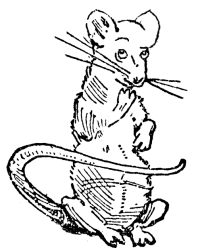 The New Scientist suggests that zoned-out rats may give us a clue to consciousness.
The New Scientist suggests that zoned-out rats may give us a clue to consciousness.
It’s all to do with the Default Mode Network, or DMN. You might think that when we stop concentrating on a particular task and sit back for a few quiet minutes the level of activity in our brains would fall, but it turns out this isn’t really so: instead, more or less the same level of activity appears to continue, but it switches to a different set of areas – in particular, a linked set of areas in the cortex and elsewhere. This is the DMN, but what is it doing?
A completely honest answer, I think, would be that we don’t exactly know except that it’s something other than concentrating on a task. In human subjects the DMN seems to be associated with daydreaming, but also with other detached modes of thought. Why would this help explain consciousness? It seems that in patients with locked-in syndrome, where consciousness is fully retained but the patient is unable to move, the DMN is functioning normally, whereas in persistent vegetative syndrome, where consciousness is absent, it is disrupted.
I can think of a further reason to think that this might shed light on consciousness. It’s not much of a stretch to see DMN activity as being the kind of thinking that isn’t directly related to inputs and outputs. When we’re working on a task those are crucial, but one plausible account of the role of consciousness is exactly that it lets us escape from giving instant responses to our surroundings and lets us develop longer-term plans, deeper understanding, and more complex behaviour. If the DMN represents useful mental activity detached from inputs and outputs it is exactly the thing whose existence the behaviourists denied, which is pretty much the same as one conception of consciousness.
The New Scientist and others speak of the DMN as associated with introspection, but I can’t see the evidence for that. To be daydreaming or thinking in general terms about stuff that is or might be going on is not introspection. I think there’s some confusion going on here between thinking internally and thinking about what’s going on internally: and perhaps a further suggestion that introspection= self-awareness = consciousness: those are tenable but debatable equations which don’t seem to be vindicated or disproved by the mere existence of the DMN. So perhaps the excitement is premature.
The rats are not that reassuring either. The New Scientist reports that analogues of the human DMN have been found in monkeys, and now even in rats. That’s interesting, but unless we rate the consciousness of rats unusually highly it seems to show that the DMN cannot explain any uniquely human level of consciousness. Fair enough: I don’t disdain rat consciousness altogether: but it’s worse than that because, as I understand it, the evidence currently suggests that younger human children don’t have an identifiable DMN. It would be somewhat weird to attribute to rats a level of reflective consciousness which is absent in human infants – wouldn’t it? If more were needed to put us off, it is not quite 100% agreed that the DMN is in fact a functional entity in itself; it could yet turn out to be more like the mere absence of the TPN, the Task Positive Network which is its opposite (or complement) – the similar set of areas which appear to work together when we’re engaged in a specific task. Perhaps the level of neuronal activity in the brain stays high, not because the DMN is really processing anything, but because the brain just uses a lot of energy to tick over?
Still, if the DMN doesn’t explain what consciousness is, it’s hard to resist the view that it’s telling us something about how it works. Problems with the DMN have been put forward as possible causes of Alzheimer’s, autism, and schizophrenia (I think everything has been put forward as a possible cause of schizophrenia). The range of problems is perhaps an indication of the vagueness of the theories. There is some good evidence of a correlation between Alzheimer’s and disrupted DMN: but then the DMN includes quite a siginficant sampling of some important areas of the brain, so that may not mean all that much. It could be that when consciousness is disrupted the DMN tends naturally to get disrupted too, without that implying that the DMN actually runs or constitutes even the less-focused forms of consciousness.
At the end of the day what we’re left with is that our brains – and even rat brains – don’t use the same circuits for task-related and non-task related activity, but go through a fairly large-scale switch of resources. Even if we’re idly daydreaming about driving into town already, it seems we bring in a different set of neurons to do it with. There has to be some good reason for this, but what…?
